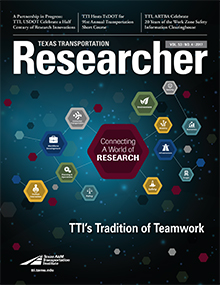
Using GPS Devices to Get Better Emissions Estimates
The World Trade Bridge crossing in the Laredo–Nuevo Laredo region is the most used Texas-Mexico port of entry (POE). The crossing’s popularity helps explain the location’s relatively high vehicle emissions, caused by high truck volumes and slow speeds as traffic makes its way across the bridge. A recent, innovative pilot program used emerging data gathering and analysis techniques to help reduce those emissions and decrease crossing times.
The pilot program helped researchers determine the most visited trucking facilities and develop maps illustrating the key freight corridors in the region.
In freight transportation, drayage refers to a segment of the supply chain where goods are hauled within one site (such as a port) or from one local site to another. POEs along the 1,220-mile Texas-Mexico border experience large volumes of drayage activities because Mexican trucks were not allowed to travel long-haul distances into the United States prior to January 2015. This restriction has spurred the growth of a large drayage industry at U.S.-Mexico border crossings. Drayage activity is a significant component of total on-road vehicle activity and, as such, a noteworthy source of mobile emissions in the Laredo–Nuevo Laredo air shed. Based on regional travel-demand models, current regional emissions inventories only partially capture the air-quality impacts of drayage trucks.
“The detailed trip data we generated allow us to better understand the total impact of the drayage truck emissions in the region. When we have speed, trip-length and trip-time information and combine it with knowing how many trucks are crossing the border, we can achieve more accurate emissions estimates.”
Reza Farzaneh, TTI Associate Research Engineer
In a study prepared for the Border Environment Cooperation Commission, Texas A&M Transportation Institute (TTI) researchers fit global positioning system (GPS) units onto a sample of 20 drayage trucks operating in the Laredo–Nuevo Laredo area. They analyzed the resulting GPS data in a GIS environment, producing very specific, trip-by-trip information on truck activity, with each trip defined by its origin, destination, start and end times, and duration.
“The detailed trip data we generated allow us to better understand the total impact of the drayage truck emissions in the region,” says TTI Associate Research Engineer Reza Farzaneh, the project’s principal investigator. “When we have speed, trip-length and trip-time information and combine it with knowing how many trucks are crossing the border, we can achieve more accurate emissions estimates.”
Those estimates provide important information to regional planners tasked with maintaining the growth of cross-border trade in the region without negatively impacting air quality.
The pilot program helped researchers determine the most visited trucking facilities and develop maps illustrating the key freight corridors in the region. When presented with the results of this study at a workshop in Laredo, border stakeholders worked to develop an action plan based on the data to improve border air quality.
Applying INRIX Data to Improve Emissions Analysis in MOVES
The Environmental Protection Agency uses MOtor Vehicle Emission Simulator (MOVES) to model and estimate mobile-source emissions. TTI’s Strategic Research Program funded a project to examine and better understand how the use of emerging sources of speed and traffic data can potentially improve and supplement the current state of the practice in mobile source emissions modeling. These new and innovative sources of archived data broadly encompass speed and traffic data collected by private companies, such as INRIX and Nokia HERE, and vehicle travel-time data collected using technologies such as Bluetooth®.

Within TTI’s Environment and Air Quality Division, staff from the Air Quality Program worked collaboratively with members of the Transportation Modeling Program, as well as TTI’s Mobility Division, which facilitated the use of sample INRIX data for the case-study analysis.
A case study of one freeway segment and one principal arterial segment in Austin, Texas, demonstrated the benefits of incorporating INRIX speed data into a MOVES-based emissions analysis. The team estimated link-level speed and emissions for both INRIX-based and travel-demand management (TDM)–based speeds. The results indicate that INRIX-based link speeds were lower than TDM-based speed during afternoon peak hours on freeways.
While the results of this single case study must be cited with caution, they demonstrate that archived traffic and speed data can be successfully incorporated into a MOVES-based emissions analysis platform. Such applications can potentially provide improved inputs to the MOVES model by providing more disaggregated and observation-based information.
